 |
 |
 |
||
|
||||
Birding in India
The Indian region is incredibly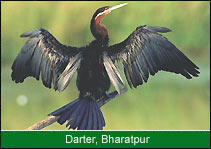 rich
in birdlife. Over 1200 of the world's 8650 species of birds are found in the
region. This number rises to over 2000 with sub species included, which makes
the Indian check-list twice the size of those of Europe and North America. This
abundance is due to the variety of habitats and climate. Altitude ranges from
sea level to the peaks of the Himalaya, the world's highest mountain range;
rainfall from its lowest in the Rajasthan desert to its highest in the north-eastern
town of Cherrapunji in Meghalaya, one of the wettest places in the world. Unlike
more temperate zones, the climate of large areas of the Indian region encourages
continuous plant growth and insect activity-abundant sources of avian nourishment
throughout the year.
rich
in birdlife. Over 1200 of the world's 8650 species of birds are found in the
region. This number rises to over 2000 with sub species included, which makes
the Indian check-list twice the size of those of Europe and North America. This
abundance is due to the variety of habitats and climate. Altitude ranges from
sea level to the peaks of the Himalaya, the world's highest mountain range;
rainfall from its lowest in the Rajasthan desert to its highest in the north-eastern
town of Cherrapunji in Meghalaya, one of the wettest places in the world. Unlike
more temperate zones, the climate of large areas of the Indian region encourages
continuous plant growth and insect activity-abundant sources of avian nourishment
throughout the year.
Himalayan Birding
The northernmost of these areas is the Himalaya, which form an arc some 2500 kilo metres long and 150 to 400 kilometres broad across the top of the sub-continent. The Himalayan mountains form roughly three parts,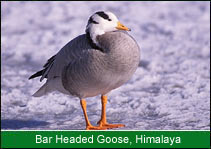 the foothills or Sivaliks to the south, the Himachal, or lower mountains, and
the Himadri or high Himalaya to the north. The Ladakh plateau, with an average
elevation of 5300 metres, occupies a large portion of the Indian state of Jammu
and Kashmir and consists of steppe country with mountain lakes where birds like
the Bar-headed Goose and Brown-headed Gull breed in summer. The state of Himachal
Pradesh, and the Kumaon and Garhwal regions of the state of Uttar Pradesh lie
to the west of Nepal, which falls almost entirely within the central Himalaya.
Further east the rainfall increases giving the Eastern Himalaya of Bhutan and
Sikkim a very different range of species from those in the west.
the foothills or Sivaliks to the south, the Himachal, or lower mountains, and
the Himadri or high Himalaya to the north. The Ladakh plateau, with an average
elevation of 5300 metres, occupies a large portion of the Indian state of Jammu
and Kashmir and consists of steppe country with mountain lakes where birds like
the Bar-headed Goose and Brown-headed Gull breed in summer. The state of Himachal
Pradesh, and the Kumaon and Garhwal regions of the state of Uttar Pradesh lie
to the west of Nepal, which falls almost entirely within the central Himalaya.
Further east the rainfall increases giving the Eastern Himalaya of Bhutan and
Sikkim a very different range of species from those in the west.
North West Birding
The north west covers the bulk of Pakistan, the flat plains of the Indian Punjab and the semi-arid and arid plains of Rajasthan in the west. The Punjab (divided now between India and Pakistan) is watered by the five rivers,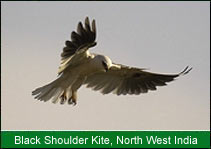 after
which it takes its name, and efficient farming on fertile soil means that it
produces an immense surplus of wheat and rice. Further west, wherever irrigation
has been possible the desert has bloomed. Mountains of red chillies,for example,
can been seen drying next to the fields around,Jodhpur, while there are verdant
paddy fields in areas irrigated by the great River Indus in Pakistan's Sindh
province.
after
which it takes its name, and efficient farming on fertile soil means that it
produces an immense surplus of wheat and rice. Further west, wherever irrigation
has been possible the desert has bloomed. Mountains of red chillies,for example,
can been seen drying next to the fields around,Jodhpur, while there are verdant
paddy fields in areas irrigated by the great River Indus in Pakistan's Sindh
province.
Areas without irrigation have to rely on the perennially deficient rainfall, but local grasses have adapted to this, and after a monsoon shower even the desert sprouts rich pasture. Much of the area is in fact thorn scrub rather than true desert. Among the numerous desert birds found in this area are many which are related to species further west. The shifting sands of the desert join ultimately with the Rann of Kutch, a large salt waste which runs into the sea, and are bordered to the south-east by the Aravallis, India's most ancient mountains.
North India Birding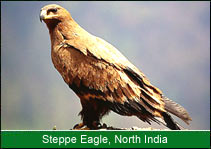
North India comprises the Gangetic plain, enriched by thousands of years of alluvial deposits brought by the River Ganga and her tributaries from the Himalaya. The Gangetic plain is densely populated and highly fertile. This region extends up to an altitude of 1000 metres in the north, which also means it includes the low foothills of the Himalaya, and the terai of India and Nepal, once a marshy area covered with dense forest. Much of the terai area has been cleared for farming but some of the forests which still exist reveal the fantastic variety of birdlife which these forests must once have supported.
Peninsular India Birding
Peninsular India, bordered on the north-west by the Aravallis and the north by the Vindhya mountains, on the west by the Arabian Sea and the east by the Bay of Bengal, makes up the largest physiographic division of India.
The central plateaus of this area, which is also known as the Deccan, rise to over 1000 metres in the south, but hardly exceed 500 metres in the north. The peninsula has some wonderful landscapes, hills and huge boulders littering the countryside, and large areas of forest. Great rivers like the Narmada rise in the heart of the peninsula and flow into the sea. The steep escarpments of the Western Ghats, the mountains which stand between the plateau and the low-lying coastal strip, catch the full force of the monsoon.
South West India Birding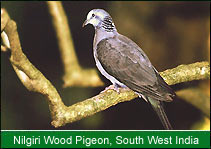
The south west region lies within the peninsula, but due to the particularly humid climate and the height of the hills here, its birds, like spiderhunters and laughing thrushes bear strong affinities with those found in the north-east and Burma. The highest of the hills here are the, Nilgiris or Blue Mountains, much of whose characteristic downland and shola forest is now under eucalyptus, tea and other plantation crops. Tea is also the main crop of the Annamalai or Elephant Mountains of Kerala, while cardamom and other spices are grown lower down. Perhaps the most ornithologically fascinating part of this area are the forests of the Wynad, where Kerala, Karnataka and Tamil Nadu meet.
North East India Birding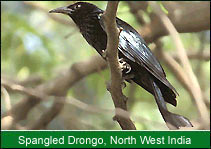
The north east and Bangladesh region consists of the delta of the Ganga and Brahmaputra, with its tidal estuaries, sandbanks, mud-flats, mangrove swamps and islands. Further upstream are .lands drained, and occasionally flooded, by these great rivers and their tributaries. The north-east region also extends northwards to include all the forest regions of the states of Arunachal Pradesh, Mizoram, Meghalaya and Nagaland, as well as the Kingdom of Bhutan. As you progress eastwards, the bird life has increasinly strong affinities with the IndoChinese sub-region.
The Indian region is incredibly
 rich
in birdlife. Over 1200 of the world's 8650 species of birds are found in the
region. This number rises to over 2000 with sub species included, which makes
the Indian check-list twice the size of those of Europe and North America. This
abundance is due to the variety of habitats and climate. Altitude ranges from
sea level to the peaks of the Himalaya, the world's highest mountain range;
rainfall from its lowest in the Rajasthan desert to its highest in the north-eastern
town of Cherrapunji in Meghalaya, one of the wettest places in the world. Unlike
more temperate zones, the climate of large areas of the Indian region encourages
continuous plant growth and insect activity-abundant sources of avian nourishment
throughout the year.
rich
in birdlife. Over 1200 of the world's 8650 species of birds are found in the
region. This number rises to over 2000 with sub species included, which makes
the Indian check-list twice the size of those of Europe and North America. This
abundance is due to the variety of habitats and climate. Altitude ranges from
sea level to the peaks of the Himalaya, the world's highest mountain range;
rainfall from its lowest in the Rajasthan desert to its highest in the north-eastern
town of Cherrapunji in Meghalaya, one of the wettest places in the world. Unlike
more temperate zones, the climate of large areas of the Indian region encourages
continuous plant growth and insect activity-abundant sources of avian nourishment
throughout the year.Himalayan Birding
The northernmost of these areas is the Himalaya, which form an arc some 2500 kilo metres long and 150 to 400 kilometres broad across the top of the sub-continent. The Himalayan mountains form roughly three parts,
 the foothills or Sivaliks to the south, the Himachal, or lower mountains, and
the Himadri or high Himalaya to the north. The Ladakh plateau, with an average
elevation of 5300 metres, occupies a large portion of the Indian state of Jammu
and Kashmir and consists of steppe country with mountain lakes where birds like
the Bar-headed Goose and Brown-headed Gull breed in summer. The state of Himachal
Pradesh, and the Kumaon and Garhwal regions of the state of Uttar Pradesh lie
to the west of Nepal, which falls almost entirely within the central Himalaya.
Further east the rainfall increases giving the Eastern Himalaya of Bhutan and
Sikkim a very different range of species from those in the west.
the foothills or Sivaliks to the south, the Himachal, or lower mountains, and
the Himadri or high Himalaya to the north. The Ladakh plateau, with an average
elevation of 5300 metres, occupies a large portion of the Indian state of Jammu
and Kashmir and consists of steppe country with mountain lakes where birds like
the Bar-headed Goose and Brown-headed Gull breed in summer. The state of Himachal
Pradesh, and the Kumaon and Garhwal regions of the state of Uttar Pradesh lie
to the west of Nepal, which falls almost entirely within the central Himalaya.
Further east the rainfall increases giving the Eastern Himalaya of Bhutan and
Sikkim a very different range of species from those in the west.North West Birding
The north west covers the bulk of Pakistan, the flat plains of the Indian Punjab and the semi-arid and arid plains of Rajasthan in the west. The Punjab (divided now between India and Pakistan) is watered by the five rivers,
 after
which it takes its name, and efficient farming on fertile soil means that it
produces an immense surplus of wheat and rice. Further west, wherever irrigation
has been possible the desert has bloomed. Mountains of red chillies,for example,
can been seen drying next to the fields around,Jodhpur, while there are verdant
paddy fields in areas irrigated by the great River Indus in Pakistan's Sindh
province.
after
which it takes its name, and efficient farming on fertile soil means that it
produces an immense surplus of wheat and rice. Further west, wherever irrigation
has been possible the desert has bloomed. Mountains of red chillies,for example,
can been seen drying next to the fields around,Jodhpur, while there are verdant
paddy fields in areas irrigated by the great River Indus in Pakistan's Sindh
province. Areas without irrigation have to rely on the perennially deficient rainfall, but local grasses have adapted to this, and after a monsoon shower even the desert sprouts rich pasture. Much of the area is in fact thorn scrub rather than true desert. Among the numerous desert birds found in this area are many which are related to species further west. The shifting sands of the desert join ultimately with the Rann of Kutch, a large salt waste which runs into the sea, and are bordered to the south-east by the Aravallis, India's most ancient mountains.
North India Birding

North India comprises the Gangetic plain, enriched by thousands of years of alluvial deposits brought by the River Ganga and her tributaries from the Himalaya. The Gangetic plain is densely populated and highly fertile. This region extends up to an altitude of 1000 metres in the north, which also means it includes the low foothills of the Himalaya, and the terai of India and Nepal, once a marshy area covered with dense forest. Much of the terai area has been cleared for farming but some of the forests which still exist reveal the fantastic variety of birdlife which these forests must once have supported.
Peninsular India Birding
Peninsular India, bordered on the north-west by the Aravallis and the north by the Vindhya mountains, on the west by the Arabian Sea and the east by the Bay of Bengal, makes up the largest physiographic division of India.
The central plateaus of this area, which is also known as the Deccan, rise to over 1000 metres in the south, but hardly exceed 500 metres in the north. The peninsula has some wonderful landscapes, hills and huge boulders littering the countryside, and large areas of forest. Great rivers like the Narmada rise in the heart of the peninsula and flow into the sea. The steep escarpments of the Western Ghats, the mountains which stand between the plateau and the low-lying coastal strip, catch the full force of the monsoon.
South West India Birding

The south west region lies within the peninsula, but due to the particularly humid climate and the height of the hills here, its birds, like spiderhunters and laughing thrushes bear strong affinities with those found in the north-east and Burma. The highest of the hills here are the, Nilgiris or Blue Mountains, much of whose characteristic downland and shola forest is now under eucalyptus, tea and other plantation crops. Tea is also the main crop of the Annamalai or Elephant Mountains of Kerala, while cardamom and other spices are grown lower down. Perhaps the most ornithologically fascinating part of this area are the forests of the Wynad, where Kerala, Karnataka and Tamil Nadu meet.
North East India Birding

The north east and Bangladesh region consists of the delta of the Ganga and Brahmaputra, with its tidal estuaries, sandbanks, mud-flats, mangrove swamps and islands. Further upstream are .lands drained, and occasionally flooded, by these great rivers and their tributaries. The north-east region also extends northwards to include all the forest regions of the states of Arunachal Pradesh, Mizoram, Meghalaya and Nagaland, as well as the Kingdom of Bhutan. As you progress eastwards, the bird life has increasinly strong affinities with the IndoChinese sub-region.
Indian Birding
Birding in India Birding Tours India
Birding Tours India  Bird Watching India
Bird Watching India  India Bird Checklist
India Bird Checklist  Habitat & Bird Species
Habitat & Bird Species
Bird Conservation
Birding in India
Bird Conservation
| Home | About Us | FAQ's | Contact Us | Commendations | Reservation |
| Copyright © Wildlife India Plus ( All Rights Reserved. ) | Web Development & SEO Services by |

